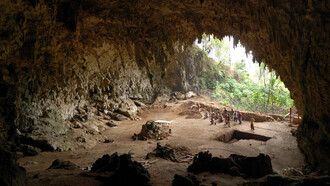If every color of a painting was a tone, and every work of art a musical composition, what would the song sound like? This is a question that might occur to the casual exhibit goer and critic alike while taking in the paintings of Dov Talpaz, now on display at Slag Gallery.
The series of colorful, graphic, and captivating paintings have a recurrent subject: the trumpet. In a majority of the works, this music instrument has been twisted and elongated, and by appearing in different forms and sizes, it becomes the main character in the tale of a composition that chants the energies through which it plays. The squared monochromatic backgrounds emphasize a mystic emptiness caused by the simplification of possible narrative elements, and there is evidence of a strong story and melody throughout each piece.
Previously known for using a more traditional and figurative painting style, this new series investigates the power of reduction of narrative components and color in search of a simpler emotional language that conveys only the intended essence of the piece. Inspired from his rich exposure to music since childhood, Talpaz amplifies the trumpet’s image, using many different perspectives, and he projects humanlike characteristics on the instrument almost to the point of confusion with the characters on his stages.
Since early practice, Talpaz has painted scenes of life that he had encountered in novels and films. One of his favourite movies, for example, is Shawshank Redemption (1994), and he was inspired by the Russian literary greats, including Dostoyevsky, Checov, and Tolstoy. In the same way he was influenced by literature and film, he used the music of John Coltrane and Thelonious Monk to guide his artistry in his trumpet series.
Talpaz reduced and flattened the images of his stories to flat, colored areas, to the sum and substance of those stories. Isolated figures are represented through lines and shapes that follow a unique harmony of color and time. The arrangement of the elements of each painting is premeditated, and the colors are chosen in advance so that they are applied subsequently, in more of a rhythmic pattern than a melodic one. The pulse of the paintings emotes a certain kind of muted energy, while remaining respectful enough to refrain from overwhelming the viewer.
In Melodic Intimacy I, 2016, for example, a trumpet dominates the scene on a pinkish background. Its tubes have been stretched to an awkward length and are torched, assuming the form of two legs that touch a shadow on the bottom. An overarching question surfaces with this particular work: do we see the shadow of the trumpet or that of an elongated figure, standing outside of the painting? The different colors that compose the trumpet’s tubes are applied in a simple way, but they invite the eye to follow the lines, and they convey the energy that hovers throughout the painting.
Red Corner (2016), on the other hand, is composed of flat colored areas and a small detail of a stylized face, potentially depicting a crude image of a clown. A peeping eye is discovered from the upper corner that slants towards the bottom of the painting, and although there is no other facial cue present, there is a certain melancholy to the face that is startlingly evident. The painting is composed by nothing more than large color fields and few signs, yet the message (and to the literary enthusiasts, the source of inspiration, Dostoyevsky’s The Brothers Karamazov) rings clear.
Music notes are fully realized when played in a time-based sequence, the audible composition. If one were to transpose one of Talpaz’s paintings into a musical piece, one would most likely require a larger staff (more than the customary five lines). And even though the works themselves might represent a rhythmic exercise of different tones, played successively one right after the other, they continue to maintain the integrity of the existing elements, colors, and shapes that all collaborate together in a perfect harmony, creating a visual symphony brimming with emotion and feeling.















